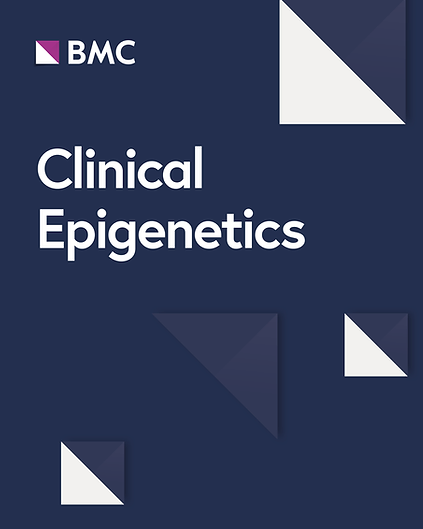Meta-analysis of epigenetic aging in schizophrenia reveals multifaceted relationships with age, sex, illness duration, and polygenic risk
IF 4.8
2区 医学
Q1 GENETICS & HEREDITY
引用次数: 0
Abstract
The study of biological age acceleration may help identify at-risk individuals and reduce the rising global burden of age-related diseases. Using DNA methylation (DNAm) clocks, we investigated biological aging in schizophrenia (SCZ), a mental illness that is associated with an increased prevalence of age-related disabilities and morbidities. In a whole blood DNAm sample of 1090 SCZ cases and 1206 controls across four European cohorts, we performed a meta-analysis of differential aging using three DNAm clocks (i.e., Hannum, Horvath, and Levine). To dissect how DNAm aging contributes to SCZ, we integrated information on duration of illness and SCZ polygenic risk, as well as stratified our analyses by chronological age and biological sex. We found that blood-based DNAm aging is significantly altered in SCZ independent from duration of the illness since onset. We observed sex-specific and nonlinear age effects that differed between clocks and point to possible distinct age windows of altered aging in SCZ. Most notably, intrinsic cellular age (Horvath clock) is decelerated in SCZ cases in young adulthood, while phenotypic age (Levine clock) is accelerated in later adulthood compared to controls. Accelerated phenotypic aging was most pronounced in women with SCZ carrying a high polygenic burden with an age acceleration of + 3.82 years (CI 2.02–5.61, P = 1.1E−03). Phenotypic aging and SCZ polygenic risk contributed additively to the illness and together explained up to 14.38% of the variance in disease status. Our study contributes to the growing body of evidence of altered DNAm aging in SCZ and points to intrinsic age deceleration in younger adulthood and phenotypic age acceleration in later adulthood in SCZ. Since increased phenotypic age is associated with increased risk of all-cause mortality, our findings indicate that specific and identifiable patient groups are at increased mortality risk as measured by the Levine clock. Our study did not find that DNAm aging could be explained by the duration of illness of patients, but we did observe age- and sex-specific effects that warrant further investigation. Finally, our results show that combining genetic and epigenetic predictors can improve predictions of disease outcomes and may help with disease management in schizophrenia.对精神分裂症表观遗传老化的元分析揭示了与年龄、性别、病程和多基因风险的多方面关系
对生物年龄加速的研究可能有助于识别高危人群,减轻与年龄有关的疾病不断增加的全球负担。我们利用DNA甲基化(DNAm)时钟研究了精神分裂症(SCZ)的生物衰老,这种精神疾病与年龄相关的残疾和发病率增加有关。在四个欧洲队列的 1090 例 SCZ 病例和 1206 例对照的全血 DNAm 样本中,我们使用三种 DNAm 时钟(即 Hannum、Horvath 和 Levine)对不同的衰老进行了荟萃分析。为了剖析DNAm衰老如何导致SCZ,我们整合了病程和SCZ多基因风险的信息,并按照生理年龄和生理性别进行了分层分析。我们发现,在 SCZ 中,基于血液的 DNAm 老化与发病以来的病程无关。我们观察到了性别特异性和非线性年龄效应,这些效应在不同的时钟之间存在差异,并指出了在 SCZ 中老化改变可能存在的不同年龄窗口。最值得注意的是,与对照组相比,SCZ 病例的细胞固有年龄(Horvath 时钟)在年轻时减慢,而表型年龄(Levine 时钟)则在成年后加速。表型老化的加速在多基因负担较高的女性 SCZ 患者中最为明显,年龄加速为 + 3.82 岁(CI 2.02-5.61,P = 1.1E-03)。表型老化和SCZ多基因风险对疾病的影响是叠加的,共同解释了高达14.38%的疾病状态变异。我们的研究为越来越多的证据表明SCZ患者的DNAm老化发生改变做出了贡献,并指出SCZ患者在年轻时的内在年龄减速,而在成年后的表型年龄加速。由于表型年龄的增加与全因死亡风险的增加有关,我们的研究结果表明,根据莱文时钟的测量,特定的、可识别的患者群体的死亡风险增加。我们的研究没有发现 DNAm 的衰老可以用患者的病程来解释,但我们确实观察到了年龄和性别特异性效应,这值得进一步研究。最后,我们的研究结果表明,将遗传学和表观遗传学预测因子结合起来可以改善对疾病结果的预测,并有助于精神分裂症的疾病管理。
本文章由计算机程序翻译,如有差异,请以英文原文为准。
求助全文
约1分钟内获得全文
求助全文
来源期刊

Clinical Epigenetics
ONCOLOGY-
自引率
5.30%
发文量
150
期刊介绍:
Clinical Epigenetics, the official journal of the Clinical Epigenetics Society, is an open access, peer-reviewed journal that encompasses all aspects of epigenetic principles and mechanisms in relation to human disease, diagnosis and therapy. Clinical trials and research in disease model organisms are particularly welcome.
 求助内容:
求助内容: 应助结果提醒方式:
应助结果提醒方式:


